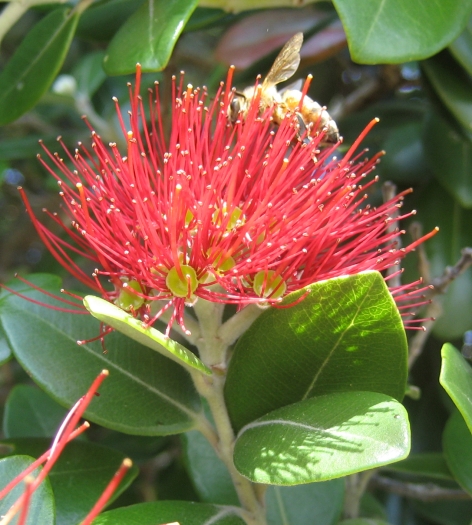New Zealand Christmas Bush
(Metrosideros kermadecensis)
New Zealand Christmas Bush (Metrosideros kermadecensis)
/
/

Kahuroa
Public domain
Image By:
Kahuroa
Recorded By:
Copyright:
Public domain
Copyright Notice:
Photo by: Kahuroa | License Type: Public domain | License URL: https://creativecommons.org/public-domain/ | Uploader: Kahuroa | Publisher: Wikimedia Commons | Title: Mkermadecensisbee.jpg | Notes: Uploaded own work with UploadWizard |































Estimated Native Range
Summary
Metrosideros kermadecensis, commonly known as New Zealand Christmas Bush, is an evergreen tree or large shrub, originally from the volcanic soils of the Kermadec Islands, located northeast of New Zealand’s North Island. It typically reaches up to 15 meters in height with a trunk diameter of 1 meter or more. The New Zealand Christmas Bush is characterized by its dense, rounded canopy and leathery, dark green leaves. It produces a spectacular display of vibrant red flowers, mainly composed of a mass of stamens, which bloom profusely and are particularly showy, attracting various pollinators. The flowering season peaks in the Southern Hemisphere’s summer, coinciding with the Christmas season, hence its common name.
The plant is valued for its striking floral display and is used in New Zealand for urban planting, as a specimen tree, and for coastal landscaping due to its salt tolerance. It is also popular as a hedge or screen plant. The variegated form adds ornamental variety to home gardens. Metrosideros kermadecensis requires full sun to thrive, benefits from medium water availability, and prefers well-drained soils. It is relatively easy to propagate from fresh seed, and cuttings can be successfully grown from water shoots. While it is a robust plant, it can be susceptible to root rot if drainage is poor. Gardeners should be aware that in some environments, such as Hawaii, it has become naturalized and may show invasive tendencies.CC BY-SA 4.0
The plant is valued for its striking floral display and is used in New Zealand for urban planting, as a specimen tree, and for coastal landscaping due to its salt tolerance. It is also popular as a hedge or screen plant. The variegated form adds ornamental variety to home gardens. Metrosideros kermadecensis requires full sun to thrive, benefits from medium water availability, and prefers well-drained soils. It is relatively easy to propagate from fresh seed, and cuttings can be successfully grown from water shoots. While it is a robust plant, it can be susceptible to root rot if drainage is poor. Gardeners should be aware that in some environments, such as Hawaii, it has become naturalized and may show invasive tendencies.CC BY-SA 4.0
Plant Description
- Plant Type: Tree, Shrub
- Height: 30-50 feet
- Width: 10-20 feet
- Growth Rate: Moderate
- Flower Color: Red, Orange
- Flowering Season: Spring, Summer
- Leaf Retention: Evergreen
Growth Requirements
- Sun: Full Sun, Part Shade
- Water: Medium
- Drainage: Medium
Common Uses
Bee Garden, Bird Garden, Butterfly Garden, Fire Resistant, Hummingbird Garden, Low Maintenance, Salt Tolerant, Showy Flowers
Natural Habitat
Originally from the volcanic soils of the Kermadec Islands
Other Names
Common Names: Kermadec Pōhutukawa, Ohi’A Haole, Pohutukawa
Scientific Names: , Metrosideros kermadecensis,
GBIF Accepted Name: Metrosideros kermadecensis W.R.B.Oliv.